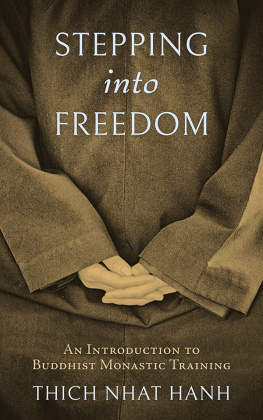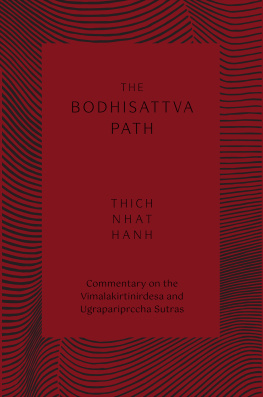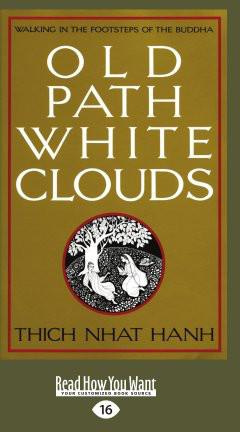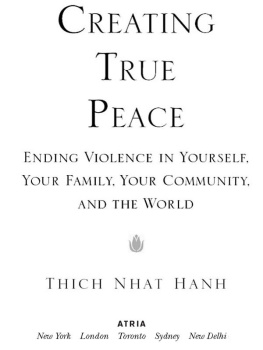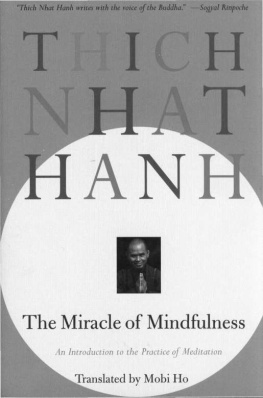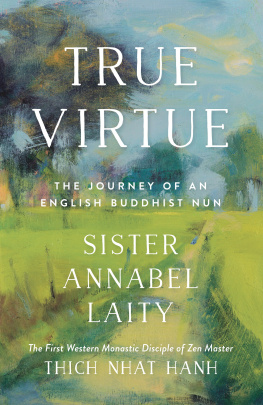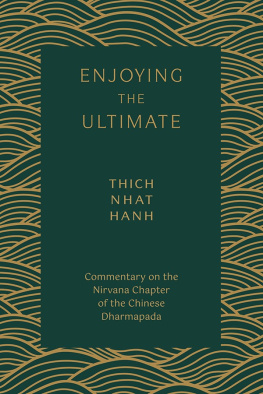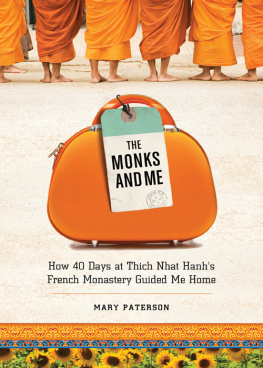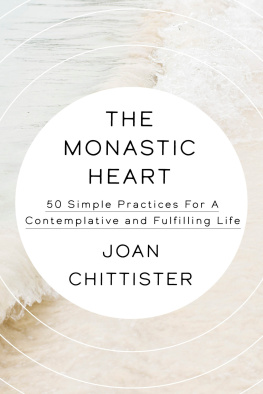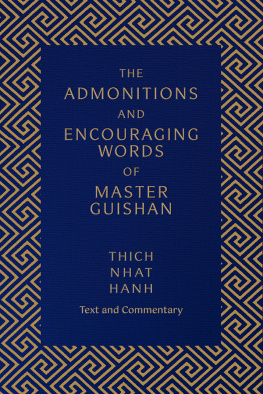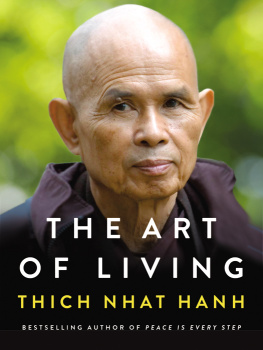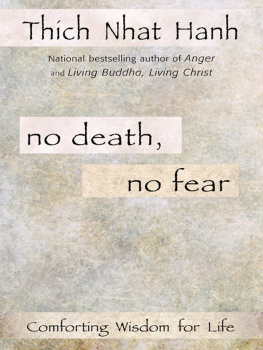
Parallax Press
2236B Sixth Street
Berkeley, California 94710
parallax.org
Parallax Press is the publishing division of Plum Village Community of Engaged Buddhism
2021 Plum Village Community of Engaged Buddhism, Inc.
All rights reserved
No part of this book may be reproduced in any form or by any means, electronic or mechanical, without permission in writing from the publisher.
Translated by Sister Annabel Laity (Sister Chan Duc)
Cover photograph by Paul Davis
Cover design by Katie Eberle
Typesetting and text design by Maureen Forys, Happenstance Type-O-Rama
Author photo Plum Village Community of Engaged Buddhism
Library of Congress Cataloging-in-Publication Data
Names: Nht Hnh, Thch, author. | Laity, Annabel, translator.
Title: Stepping into freedom : an introduction to Buddhist monastic
training / Thich Nhat Hanh ; translated by Sister Annabel Laity.
Other titles: Ni vi ngi xut gia tr tui. English
Description: Second edition. | Berkeley, California : Parallax Press,
[2021] | Includes bibliographical references.
Identifiers: LCCN 2021032137 (print) | LCCN 2021032138 (ebook) | ISBN
9781952692000 (trade paperback) | ISBN 9781952692017 (ebook)
Subjects: LCSH: Monastic and religious life (Buddhism) | Buddhist novices.
| Buddhist monasticism and religious ordersRules.
Classification: LCC BQ6128.V5 N4313 2021 (print) | LCC BQ6128.V5 (ebook)
| DDC 294.3/657dc23
LC record available at https://lccn.loc.gov/2021032137
LC ebook record available at https://lccn.loc.gov/2021032138
Related books by Thich Nhat Hanh
- The Mindfulness Survival Kit: Five Essential Practices
- Interbeing, 4th Edition: The 14 Mindfulness Trainings of Engaged Buddhism
- Joyfully Together: The Art of Building a Harmonious Community
- Freedom Wherever We Go: A Buddhist Monastic Code for the Twenty-First Century
- The Admonishments and Encouraging Words of Master Guishan
Foreword
When we step into the monastery, we feel right away a sense of harmonious order: a peaceful, serene atmosphere far from the chaotic busyness of life outside. Where does this order and peace come from? Monastic culture, transmitted from the time of the Buddha through more than a hundred generations, creates conditions for this peace. The instructions in this little book that you hold in your hands contain the essence of this monastic culture.
In the 1980s, when I asked our teacher, Thch Nht Hnh, to allow me to ordain as a Buddhist nun, he did not give his consent right away. In fact, I had to ask many times before I received it. My father had told me once that when he asked my mother if she would marry him, she said she needed time to think about it. Our teacher needed time to think about starting a monastic order in Plum Village; I also needed time to see if I had the capacity to be a nun. The commitment to monastic life is not a light one; it is a lifelong commitment to a way of living very different from the one we knew before. We commit ourselves because we know that this is the way to freedoma deep inner freedom that is not possible without discipline and a Sangha. Our teacher and I did not yet know if I would be able to keep that commitment or whether I would be happy as a nun. So, I needed to wait two more years for ordination.
After I ordained, I was given a copy of the twenty-four chapters on fine manners compiled by Master Zhuhong in the sixteenth century, which had been translated into Vietnamese. As soon as my Vietnamese was proficient enough, I did my best to translate it into English, and, soon afterwards, I wrote a commentary on it. Some points of the commentary were matters of etiquette, hygiene, or common sense. Some resembled the table manners I had learnt from my parents and school teachers.
Much of this traditional content was new to me. I needed to train not to leave my socks lying just anyhow alongside my bed but to fold and place them neatly. I could not just quickly undo the top buttons of my robe and then pull it up over my head. Every button had to be undone and then done up again with mindfulness when I put the robe back on again. There were many everyday actions that I had been accustomed to performing on automatic pilot as my mind made plans for the future or ruminated about the past. Now I had the opportunity to enjoy these actions fully with the help of a short verse known as a gth and mindful breathing. It may have taken longer to do things, but in the end they were done wellwith attention and awarenessand did not need to be done a second time. I realized that as I was able to stay present in the action, I was nourishing concentration and insight. That insight consisted of being in touch with the wonders of life, that before I had taken for granted. Every moment of life can be precious if we are able to stay in the present moment.
Our teacher was very patient with me. I learnt under his steady gaze that being a nun was adopting a culture not entirely different frombut certainly not the same asthe culture in which I had been brought up. He did not want to constrain me in an alien discipline but rather to show me that inner and outer beauty should reflect each other. It was important to wear the correct robe neatly when in public so that people could find the sight of a monk or a nun pleasant and inspiring to look at. It was important to move about serenely in order to generate the energy of mindfulness and peace and not to disturb the atmosphere. It was important to show respect to your teacher and elders in gratitude for the fact that they were taking the trouble to train you and impart their insight to you. Even if you did not always understand them, your part as a student or disciple was to listen without preconceived ideas. At a later date, when you had reflected on their teachings, you could come back and ask for clarification. I learnt that an enlightened teacher will do anything they can to help their disciple attain awakening.
Wonderful as Master Zhuhongs instructions were, they were, by the end of the twentieth century, somewhat antiquated. As far as monastic discipline is concerned, there are some points that are timeless. There are also points, though, that need to be revised according to the times and the culture of the society in which the monastic order finds itself. Towards the end of the twentieth century, our teacher along with some of his senior disciples began to make revisions to Master Zhuhongs instructions based on that need. By 1997 the revisions were complete. Parallax Press published the first edition of Stepping into Freedom, the title of the updated instructions, and so they were made available to lay practitioners as well as monastics.
Somehow a copy of the book came into the hands of a person in prison in the United States. He was so inspired while reading it that he decided to turn his prison cell into a monks cell and to see his prison as a monastery. He shaved his own head and undertook to practice the Ten Novice Precepts and the fine manners for a novicein fact all that is in the bookand he found fulfillment and liberation in doing so. He was not the only layperson to practice the Ten Mindfulness Trainings in this book. We have since heard from many others that they have done so, whether in their own homes or in a practice center with friends.
Stepping into Freedom was first published more than twenty years ago. A revised edition was made in 2008 in Vietnamese. Our teacher, a poet, included many new gthsshort poems for the practice of mindfulness. Poetry is very difficult to translate, so please forgive us for not being able to convey all the lyrical beauty of the Vietnamese. Here is an example for washing the dishes:
Next page
